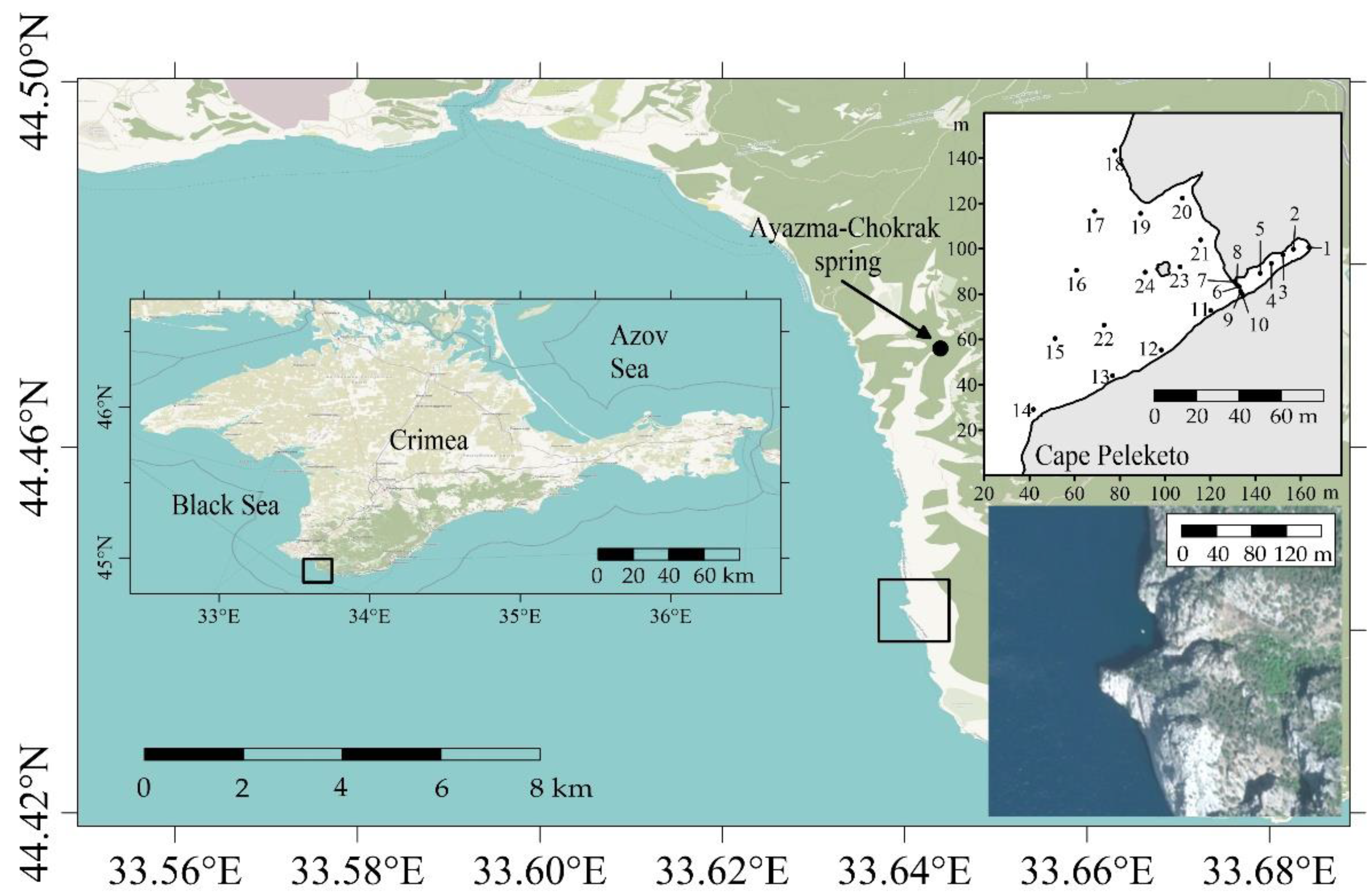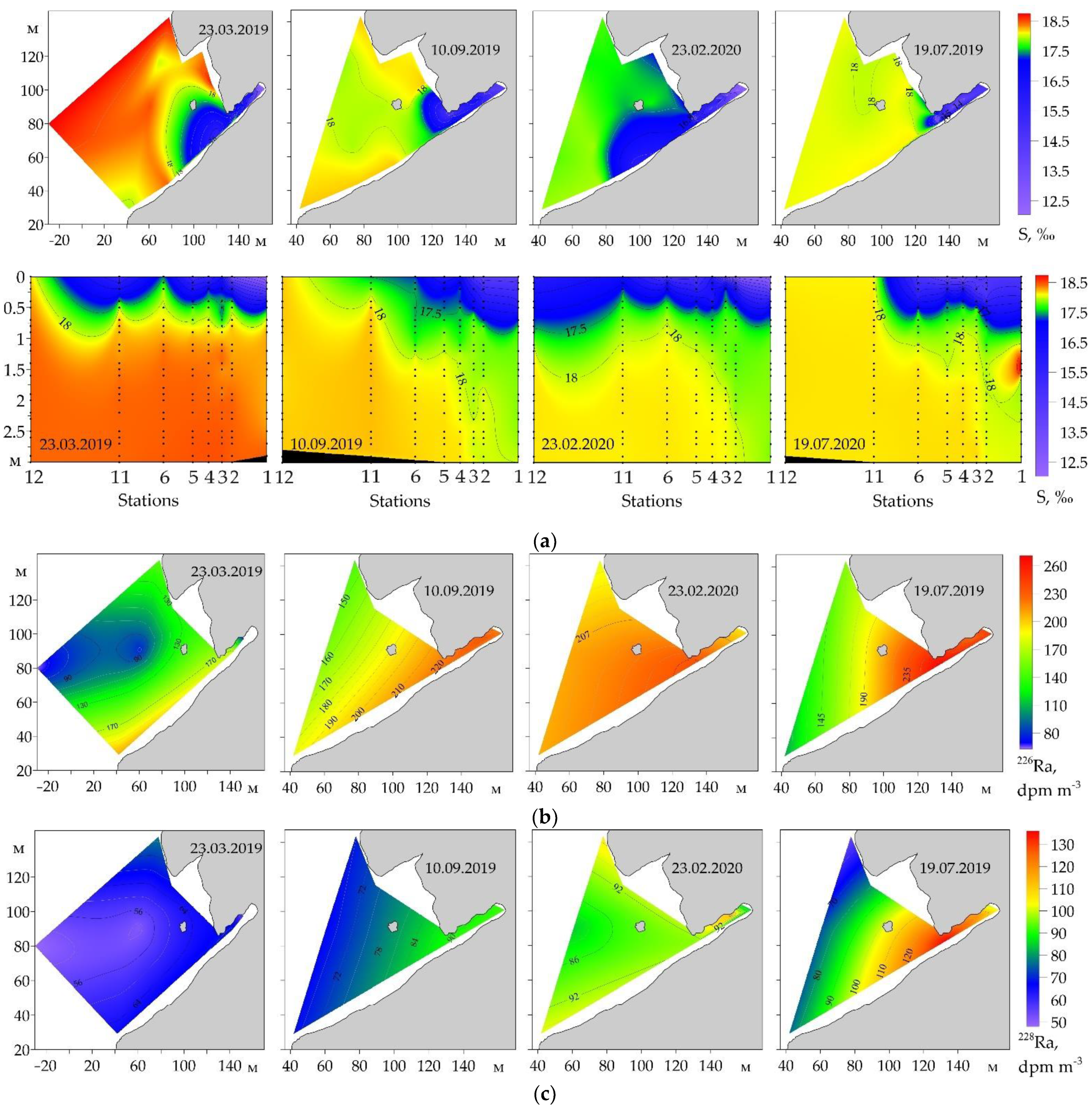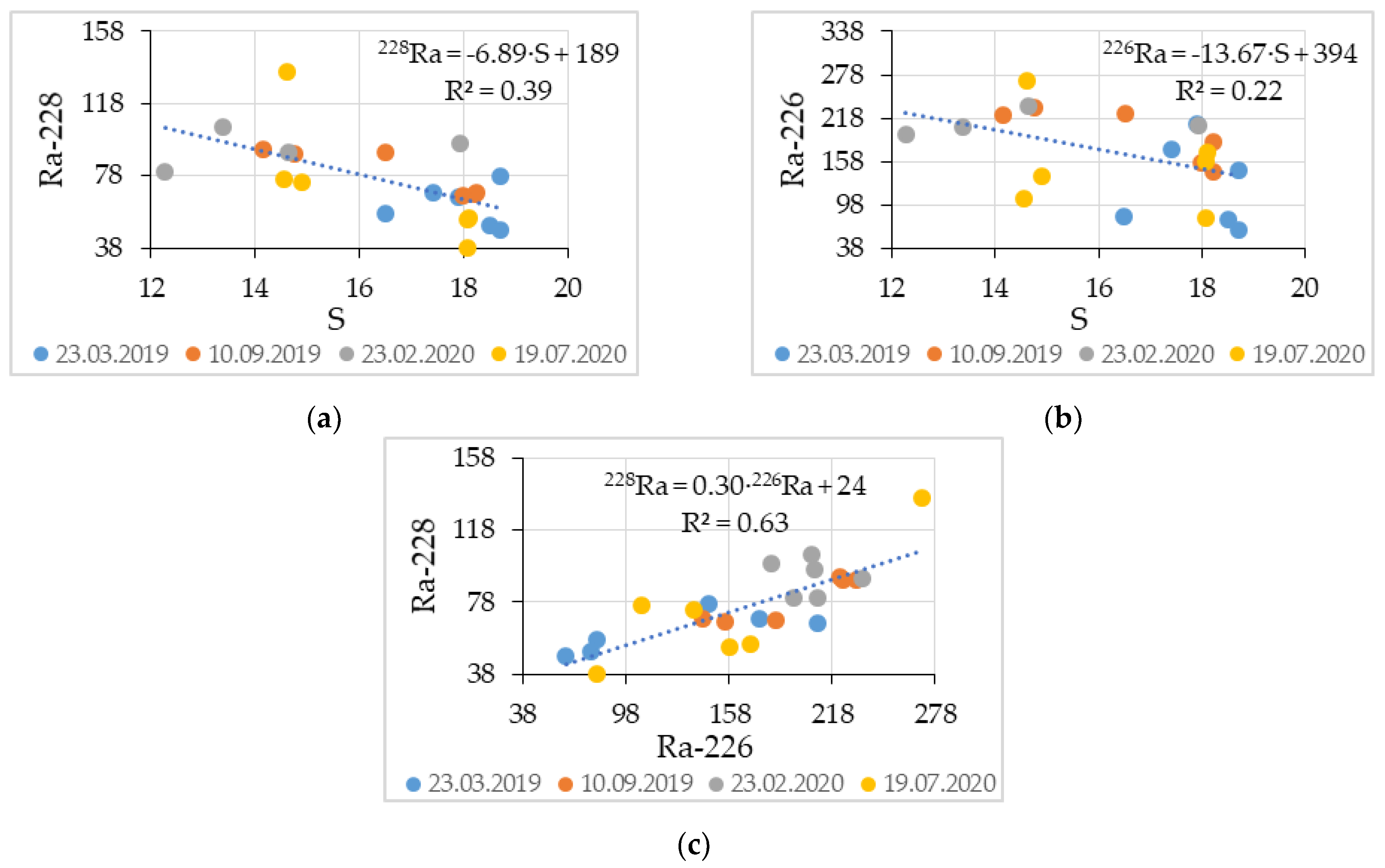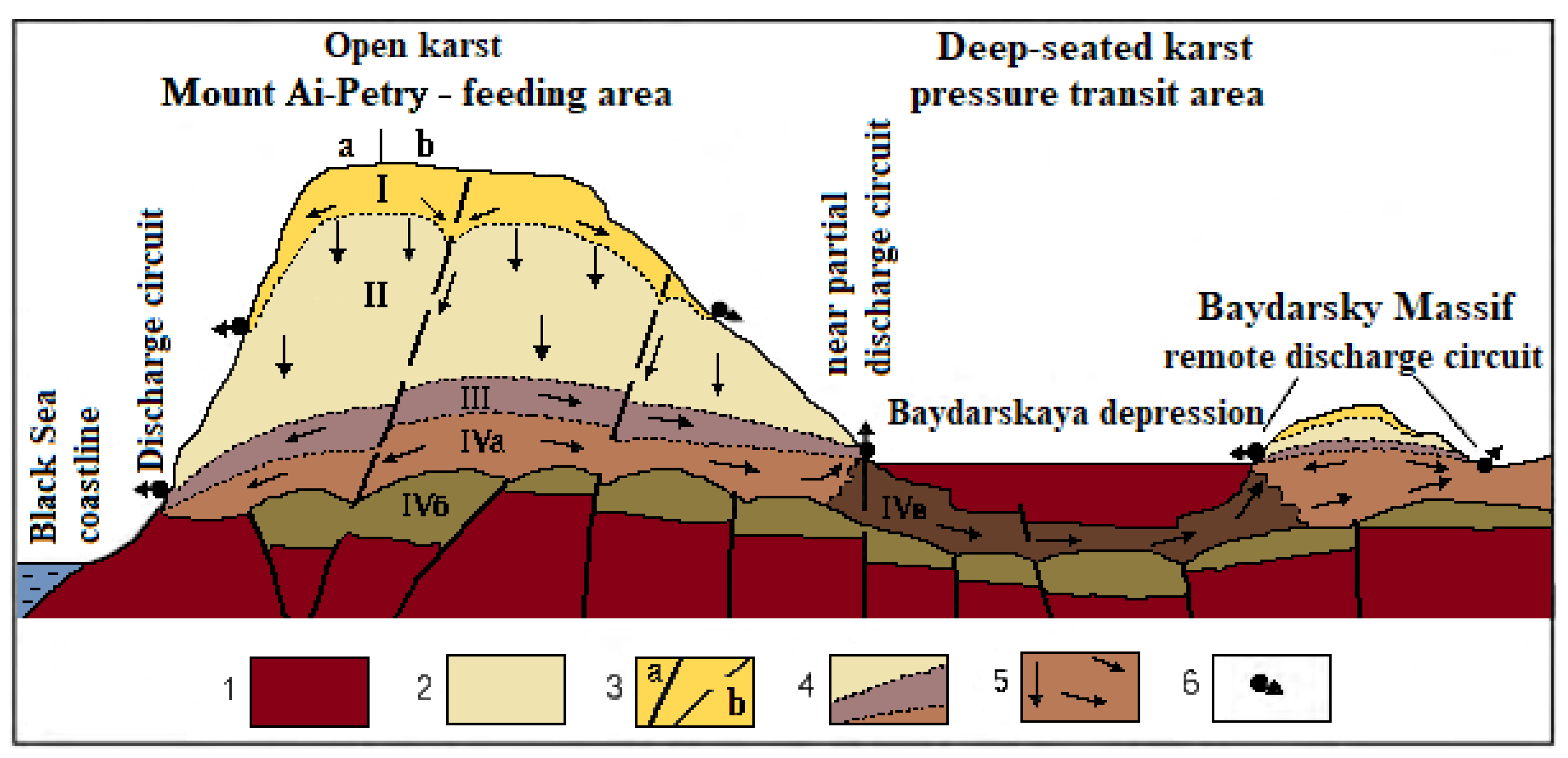Seasonal Variability of Nutrients and Radium Isotope Fluxes from Submarine Karstic Spring at the Southwest of Crimea, Black Sea
Abstract
1. Introduction
2. Materials and Methods
2.1. Coastal Expedition and Sampling
2.2. Calculations
3. Results and Discussion
3.1. Ra Isotopes
3.2. Nutrients
3.3. Vulnerability of Submarine Groundwater of Karst Origin under Anthropogenic Influence
3.4. Assessment of the Possibility of Capturing Submarine Springs of Cape Ayia
3.5. Seasonal Variability of the Distribution of Parameters, Fluxes of Submarine Spring, and Nutrients
- the flux of the submarine spring;
- meteorological conditions during the expedition;
- hydrological conditions in the area;
- seasonal nature of intensity of the biogeochemical processes in seawater.
- expedition 24 March 2019—68.8 mm (plus the income from melting snow cover from 59 to 9 mm);
- expedition 10 September 2019—18 mm;
- expedition 23 February 2020—335 mm;
- expedition 19 July 2020—169 mm.
4. Conclusions
Author Contributions
Funding
Institutional Review Board Statement
Informed Consent Statement
Data Availability Statement
Acknowledgments
Conflicts of Interest
References
- Jiang, S.; Ibánhez, J.S.P.; Wu, Y.; Zhang, J. Geochemical tracers in submarine groundwater discharge research: Practice and challenges from a view of climate changes. Environ. Rev. 2021, 29, 242–259. [Google Scholar] [CrossRef]
- Santos, I.R.; Chen, X.; Lecher, A.L.; Sawyer, A.H.; Moosdorf, N.; Rodellas, V.; Tamborski, J.; Cho, H.-M.; Dimova, N.; Sugimoto, R.; et al. Submarine groundwater discharge impacts on coastal nutrient biogeochemistry. Nat. Rev. Earth Environ. 2021, 2, 307–323. [Google Scholar] [CrossRef]
- Garcia-Orellana, J.; Rodellas, V.; Tamborski, J.; Diego-Feliu, M.; van Beek, P.; Weinstein, Y.; Charette, M.; Alorda-Kleinglass, A.; Michael, H.A.; Stieglitz, T.; et al. Radium isotopes as submarine groundwater discharge (SGD) tracers: Review and recommendations. Earth-Sci. Rev. 2021, 219, 103681. [Google Scholar] [CrossRef]
- Moosdorf, N.; Böttcher, M.E.; Adyasari, D.; Erkul, E.; Gilfedder, B.S.; Greskowiak, J.; Jenner, A.-K.; Kotwicki, L.; Massmann, G.; Müller-Petke, M.; et al. A State-Of-The-Art Perspective on the Characterization of Subterranean Estuaries at the Regional Scale. Front. Earth Sci. 2021, 9, 601293. [Google Scholar] [CrossRef]
- Bishop, J.M.; Glenn, C.R.; Amato, D.W.; Dulai, H. Effect of land use and groundwater flow path on submarine groundwater discharge nutrient flux. J. Hydrol. Reg. Stud. 2017, 11, 194–218. [Google Scholar] [CrossRef]
- Tamborski, J.; van Beek, P.; Conan, P.; Pujo-Pay, M.; Odobel, C.; Ghiglione, J.F.; Seidel, J.L.; Arfib, B.; Diego-Feliu, M.; Garcia-Orellana, J.; et al. Submarine karstic springs as a source of nutrients and bioactive trace metals for the oligotrophic Northwest Mediterranean Sea. Sci. Total Environ. 2020, 732, 139106. [Google Scholar] [CrossRef]
- Fleury, P. Sources Sous-Marines et Aquiferes Karstiques Côtiers Mediterraneens. Fonctionnement et Caracterisation. Ph.D. Thesis, Université Pierre et Marie Curie, Paris, France, 2005. [Google Scholar]
- Rodellas, V. Evaluating Submarine Groundwater Discharge to the Mediterranean Sea by Using Radium Isotopes. Ph.D. Thesis, Universitat Autònoma de Barcelona, Barcelona, Spain, 2014. [Google Scholar]
- Rodellas, V.; Garcia-Orellana, J.; Masqué, P.; Feldman, M.; Weinstein, Y. Submarine groundwater discharge as a major source of nutrients to the Mediterranean Sea. Proc. Natl. Acad. Sci. USA 2015, 112, 3926–3930. [Google Scholar] [CrossRef]
- Zektser, I.S.; Dzhamalov, R.G. Submarine Groundwater; Everett, L.G., Ed.; CRC Press, Taylor & Francis Group: New York, NY, USA, 2007. [Google Scholar]
- Kondratev, S.I.; Shchetinin, Y.T.; Dolotov, N.N.; Androsovich, A.I. Hydrological and chemical characteristics of the submarine freshwater source near Cape Aiya. Phys. Oceanogr. 1998, 9, 217–224. [Google Scholar] [CrossRef]
- Kondratev, S.I.; Dolotov, V.V.; Moiseev, Y.G.; Shchetinin, Y.T. Submarine springs of fresh water in the region from Cape Feolent to Cape Sarych. Phys. Oceanogr. 2000, 10, 257–272. [Google Scholar] [CrossRef]
- Kondratiev, S.I.; Prusov, A.V.; Yurovsky, Y.G. Observations of submarine discharge of groundwater (Southern coast of Crimea). Phys. Oceanogr. 2010, 20, 28–41. [Google Scholar] [CrossRef]
- Schubert, M.; Knöller, K.; Stollberg, R.; Mallast, U.; Ruzsa, G.; Melikadze, G. Evidence for Submarine Groundwater Discharge into the Black Sea—Investigation of Two Dissimilar Geographical Settings. Water 2017, 9, 468. [Google Scholar] [CrossRef]
- Klimchouk, A. Krubera (Voronja) Cave. In Encyclopedia of Caves, 2nd ed.; White, W.B., Culver, D.C., Eds.; Academia Press: New York, NY, USA, 2012; pp. 443–450. [Google Scholar] [CrossRef]
- Schubert, M.; Scholten, J.; Schmidt, A.; Comanducci, J.; Pham, M.; Mallast, U.; Knoeller, K. Submarine Groundwater Discharge at a Single Spot Location: Evaluation of Different Detection Approaches. Water 2014, 6, 584–601. [Google Scholar] [CrossRef]
- Chen, X.; Cukrov, N.; Santos, I.R.; Rodellas, V.; Cukrov, N.; Du, J. Karstic submarine groundwater discharge into the Mediterranean: Radon-based nutrient fluxes in an anchialine cave and a basin-wide upscaling. Geochim. Cosmochim. Acta 2020, 268, 467–484. [Google Scholar] [CrossRef]
- Submarine groundwater discharge: Management implications, measurements and effects. In IOC Manuals and Guides 44; UNESCO: Paris, France, 2004.
- Nuclear and Isotopic Techniques for the Characterization of Submarine Groundwater Discharge in Coastal Zones. In Results of a Coordinat-ed Research Project, 2001–2006; IAEA: Vienna, Austria, 2008.
- Jou-Claus, S.; Folch, A.; Garcia-Orellana, J. Applicability of Landsat 8 thermal infrared sensor for identifying submarine groundwater discharge springs in the Mediterranean Sea basin. Hydrol. Earth Syst. Sci. 2021, 25, 4789–4805. [Google Scholar] [CrossRef]
- Novikov, I.S.; Borisenko, D.A. Geomorphology and neotectonics of southwestern crimea. Russ. Geol. Geophys. 2021, 4, 483–497. [Google Scholar] [CrossRef]
- Falkner, K.K.; O’Neill, D.J.; Todd, J.F.; Moore, W.S.; Edmond, J.M. Depletion of barium and radium-226 in Black Sea surface waters over the past thirty years. Nature 1991, 350, 491–494. [Google Scholar] [CrossRef]
- O’Neill, D.J.; Todd, J.F.; Moore, W.S. 226Ra in the Black Sea and Sea of Marmara. Earth Planet. Sci. Lett. 1992, 110, 7–21. [Google Scholar] [CrossRef]
- Moore, W.S.; Falkner, K.K. Cycling of radium and barium in the Black Sea. J. Environ. Radioact. 1999, 43, 247–254. [Google Scholar] [CrossRef]
- Moore, W.S. Oceanic concentrations of 228Radium. Earth Planet. Sci. Lett. 1969, 6, 437–446. [Google Scholar] [CrossRef]
- Dovhyi, I.I.; Kremenchutskii, D.A.; Bezhin, N.A.; Shibetskaya, Y.G.; Tovarchii, Y.Y.; Egorin, A.M.; Tokar, E.A.; Tananaev, I.G. MnO2 fiber as a sorbent in oceanographic investigations. J. Radioanal. Nucl. Chem. 2020, 323, 539–547. [Google Scholar] [CrossRef]
- Marine Tech, Expert in Marine Environment, USV and Survey. Available online: http://www.marinetech.fr/ (accessed on 5 November 2021).
- Dovhyi, I.I.; Bezhin, N.A.; Kremenchutskii, D.A.; Kozlovskaia, O.N.; Chepyzhenko, A.I.; Verterich, A.V.; Tovarchiy, Y.Y.; Shibetskaya, Y.G.; Chaykin, D.Y. Multi-tracer Approach to Submarine Groundwater Discharge at Cape Ayia. Phys. Oceanogr. 2021, 28, 52–66. [Google Scholar] [CrossRef]
- Dovhyi, I.I.; Bezhin, N.A.; Tananaev, I.G. Sorption methods in marine radiochemistry. Russ. Chem. Rev. 2021, 90, 1544–1565. [Google Scholar] [CrossRef]
- Moore, W.S. Sources and fluxes of submarine groundwater discharge delineated by radium isotopes. Biogeochemistry 2003, 66, 75–93. [Google Scholar] [CrossRef]
- Gurov, K.I.; Ovsyany, E.I.; Kotelyanets, E.A.; Konovalov, S.K. Factors of formation and features of physical and chemical characteristics of the bottom sediments in the Balaklava Bay (the Black Sea). Phys. Oceanogr. 2015, 31, 46–52. [Google Scholar] [CrossRef]
- Hwang, D.-W.; Kim, G.; Lee, Y.-W.; Yang, H.-S. Estimating submarine inputs of groundwater and nutrients to a coastal bay using radium isotopes. Mar. Chem. 2005, 96, 61–71. [Google Scholar] [CrossRef]
- Hwang, D.-W.; Lee, I.-S.; Choi, M.; Kim, T.-H. Estimating the input of submarine groundwater discharge (SGD) and SGD-derived nutrients in Geoje Bay, Korea using (222)Rn-Si mass balance model. Mar. Pollut. Bull. 2016, 110, 119–126. [Google Scholar] [CrossRef] [PubMed]
- Pain, A.J.; Martin, J.B.; Young, C.R.; Valle-Levinson, A.; Mariño-Tapia, I. Carbon and phosphorus processing in a carbonate karst aquifer and delivery to the coastal ocean. Geochim. Cosmochim. Acta 2020, 269, 484–495. [Google Scholar] [CrossRef]
- Rengarajan, R.; Sarin, M.M.; Somayajulu, B.L.K.; Suhasini, R. Mixing in the surface waters of the western Bay of Bengal using 228Ra and 226Ra. J. Mar. Res. 2002, 60, 255–279. [Google Scholar] [CrossRef][Green Version]
- Chen, X.; Wang, J.; Cukrov, N.; Du, J. Porewater-derived nutrient fluxes in a coastal aquifer (Shengsi Island, China) and its implication. Estuar. Coast. Shelf Sci. 2019, 218, 204–211. [Google Scholar] [CrossRef]
- Bejannin, S.; Tamborski, J.J.; van Beek, P.; Souhaut, M.; Stieglitz, T.; Radakovitch, O.; Claude, C.; Conan, P.; Pujo-Pay, M.; Crispi, O.; et al. Nutrient Fluxes Associated With Submarine Groundwater Discharge From Karstic Coastal Aquifers (Côte Bleue, French Mediterranean Coastline). Front. Environ. Sci. 2020, 7, 205. [Google Scholar] [CrossRef]
- Price, R.M.; Savabi, M.R.; Jolicoeur, J.L.; Roy, S. Adsorption and desorption of phosphate on limestone in experiments simulating seawater intrusion. Appl. Geochem. 2010, 25, 1085–1091. [Google Scholar] [CrossRef]
- Pribluda, V.D.; Kojaspirov, A.A.; Dubliansky, V.N. Groundwater balance of the southwestern part of the mountain Crimea. Geol. J. 1979, 39, 38–45. (In Russian) [Google Scholar]
- Novikov, D.A.; Chernykh, A.V.; Dultsev, F.F. A new look at the hydrogeological conditions of the city of federal significance Sevastopol. Bull. Tomsk. Polytech. Univ. Geo-Resour. Eng. 2019, 330, 105–122. (In Russian) [Google Scholar]
- Ovsyany, E.I.; Orekhova, N.A. Hydrochemical Regime of the River Chernaya (Crimea): Environmental Aspects. Phys. Oceanogr. 2018, 25, 77–88. [Google Scholar] [CrossRef]
- Baysarovich, I.M. Formation and Submarine Discharge of Fractured-Karst Waters in the Coastal Zone of the Black Sea; Mechnykov National University: Odessa, Ukraine, 1990. (In Russian) [Google Scholar]
- Tokarev, S.V. Vulnerability of Karst Grounwater of Mountain Crimea to Pollution: Identification, Assessment and Mapping; Vernadsky Crimean Federal University: Simferopol, Ukraine, 2020. (In Russian) [Google Scholar]
- Fleury, P.; Bakalowicz, M.; Marsily, G. Submarine springs and coastal karst aquifers. A review. J. Hydrol. 2007, 339, 79–92. [Google Scholar] [CrossRef]
- Weather Ai-Petri. Available online: http://meteocenter.net/33998_fact.htm (accessed on 5 November 2021). (In Russian).








| 23 March 2019 | 10 September 2019 | 23 February 2020 | 19 July 2020 | ||||
|---|---|---|---|---|---|---|---|
| H, m | v, cm/s | H, m | v, cm/s | H, m | v, cm/s | H, m | v, cm/s |
| 0.2 | 11.9 | 0.2 | 6.0 | 0.1 | 11.0 | 0.1 | 17.0 |
| 0.5 | 12.2 | 1.2 | 5.5 | 1.4 | 7.0 | 1.1 | 9.0 |
| 4.0 | 11.6 | 3.3 | 5.5 | 3.7 | 7.0 | 3.5 | 13.0 |
| 7.7 | 12.0 | 6.7 | 3.5 | 6.1 | 3.0 | 7.1 | 2.0 |
| Season | Submarine Water Fluxes Calculated by the Parameters, m3/day | Nutrient Fluxes, g/day | ||||||||||||
|---|---|---|---|---|---|---|---|---|---|---|---|---|---|---|
| 226Ra | 228Ra | S | Si | DIP | NH4+ | NO3− | Mean | Si | DIP | TDP | NH4+ | NO2− | NO3− | |
| Spring | 7530 | 7960 | 7235 | 9540 | 9930 | 5390 2 | 7110 | 8220 | 23,980 | 97 | 115 | 135 | 106 | 5360 |
| Autumn | 4030 | 4170 | 4350 | 3735 | 6740 2 | 4750 | 4050 | 4100 | 16,600 | 45 | – 1 | – 1 | 10 | 3650 |
| Winter | 7780 | 8390 | 7645 | 10,520 | 14,415 2 | 8610 | 12,490 | 9360 | 35,300 | 170 | 330 | 270 | 29 | 7350 |
| Summer | 13,920 | 14,350 | 14,030 | 15,250 | 22,350 2 | 33,330 2 | 15,400 | 13,900 | 52,100 | 222 | 226 | 480 | – 1 | 9950 |
| Season | Dependence of the Concentration of Nutrients on Salinity and Squared Correlation Coefficient for Each Dependence | Concentration in “Groundwater”, μM | ||||||||||
|---|---|---|---|---|---|---|---|---|---|---|---|---|
| Si | DIP | TDP | NH4+ | NO2− | NO3− | Si | DIP | TDP | NH4+ | NO2− | NO3− | |
| Spring | 107.0–5.1·S R2 = 0.57 | 0.38–0.01·S R2 = 0.54 | 0.46–0.01·S R2 = 0.25 | 1.22–0.06·S R2 = 0.71 | 0.95–0.04·S R2 = 0.61 | 48.3–2.5·S R2 = 0.35 | 103.5 | 0.37 | 0.45 | 1.18 | 0.92 | 46.6 |
| Autumn | 149.9–8.0·S R2 = 0.77 | 0.36–0.02·S R2 = 0.3 | 0.02 + 0.01·S R2 = 0.02 | −0.38 + 0.05·S R2 = 0.08 | 0.19–0.01·S R2 = 0.76 | 66.1–3.5·S R2 = 0.07 | 144.3 | 0.35 | – 1 | – 1 | 0.18 | 63.6 |
| Winter | 162.0–8.5·S R2 = 0.74 | 0.70–0.03·S R2 = 0.55 | 1.35–0.06·S R2 = 0.72 | 2.43–0.10·S R2 = 0.58 | 0.27–0.01·S R2 = 0.60 | 67.3–3.4·S R2 = 0.4 | 156.0 | 0.68 | 1.31 | 2.36 | 0.26 | 64.9 |
| Summer | 115.9–6.1·S R2 = 0.61 | 0.50–0.02·S R2 = 0.45 | 0.47–0.02·S R2 = 0.45 | 2.41–0.11·S R2 = 0.24 | 0.002–0.002·S R2 = 0.74 | 50.6–2.6·S R2 = 0.07 | 111.6 | 0.49 | 0.46 | 2.33 | – 1 | 48.7 |
| Concentration, µM | |||||
|---|---|---|---|---|---|
| Si | DIP | TDP | NH4+ | NO2− | NO3− |
| 142.8 | 0.06 | 0.06 | 1.25 | 0.18 | 6.34 |
Publisher’s Note: MDPI stays neutral with regard to jurisdictional claims in published maps and institutional affiliations. |
© 2022 by the authors. Licensee MDPI, Basel, Switzerland. This article is an open access article distributed under the terms and conditions of the Creative Commons Attribution (CC BY) license (https://creativecommons.org/licenses/by/4.0/).
Share and Cite
Dovhyi, I.I.; Kozlovskaia, O.N.; Bezhin, N.A.; Shibetskaia, I.G.; Chepyzhenko, A.I.; Tananaev, I.G. Seasonal Variability of Nutrients and Radium Isotope Fluxes from Submarine Karstic Spring at the Southwest of Crimea, Black Sea. Water 2022, 14, 568. https://doi.org/10.3390/w14040568
Dovhyi II, Kozlovskaia ON, Bezhin NA, Shibetskaia IG, Chepyzhenko AI, Tananaev IG. Seasonal Variability of Nutrients and Radium Isotope Fluxes from Submarine Karstic Spring at the Southwest of Crimea, Black Sea. Water. 2022; 14(4):568. https://doi.org/10.3390/w14040568
Chicago/Turabian StyleDovhyi, Illarion I., Ol’ga N. Kozlovskaia, Nikolay A. Bezhin, Iuliia G. Shibetskaia, Aleksey I. Chepyzhenko, and Ivan G. Tananaev. 2022. "Seasonal Variability of Nutrients and Radium Isotope Fluxes from Submarine Karstic Spring at the Southwest of Crimea, Black Sea" Water 14, no. 4: 568. https://doi.org/10.3390/w14040568
APA StyleDovhyi, I. I., Kozlovskaia, O. N., Bezhin, N. A., Shibetskaia, I. G., Chepyzhenko, A. I., & Tananaev, I. G. (2022). Seasonal Variability of Nutrients and Radium Isotope Fluxes from Submarine Karstic Spring at the Southwest of Crimea, Black Sea. Water, 14(4), 568. https://doi.org/10.3390/w14040568








